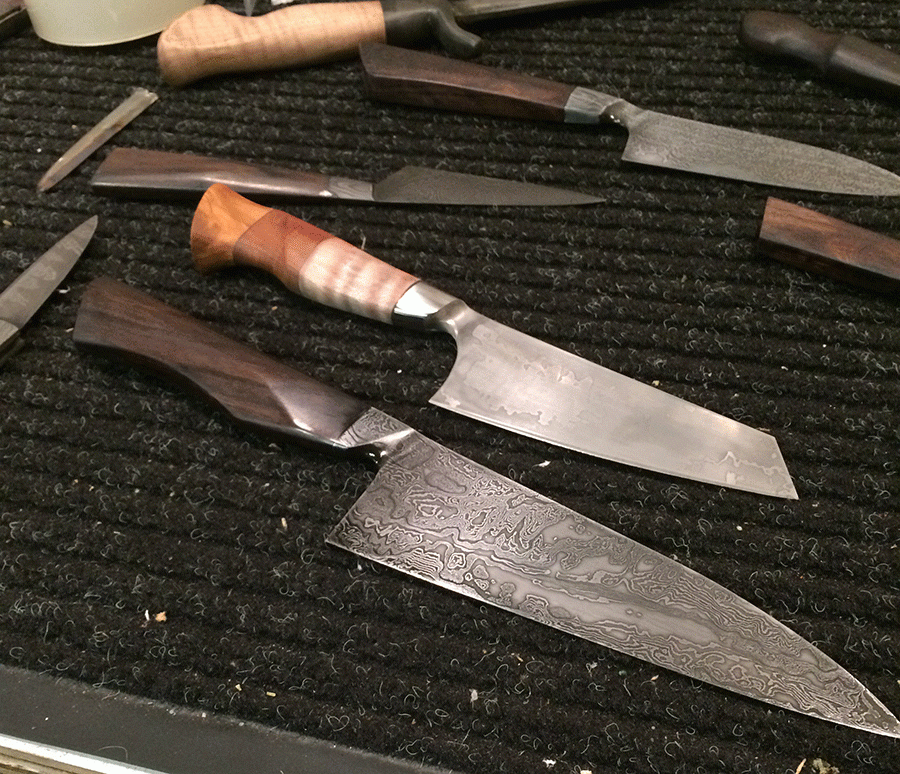Knives of Anger
“This is nothing but potential,” Johnson master blade smith Nick Anger says, holding out a piece of metal the size of a brick, a piece of metal that will eventually be transformed into a knife of otherworldly beauty.
After graduating from Johnson State College with a degree in Anthropology and Sociology, with a minor in Political science, he now has what he calls a “beautiful outlet”: creating original knifes and swords that he says are born from his need to express his emotions therapeutically. Anger has been in his shop for three years.
“I learned how to use metal from working with my best friend and roommate Harlan Mack. I just continued to find and discover new ways to advance with metal,” Anger said. “When I first started working with metal I was working at Laraway Youth and Family services and had a hard time decompressing my brain after working with the kids. I was putting in 43+ hours a weekend working at a facility that didn’t have the best support.”
In 2007 Anger was exposed to forging by Corrina Mensoff, a metal worker, when Mack was a resident artist at the Vermont Studio Center.
At first glance, Anger’s blades appear to have some elaborate engraving on them, but it is something else entirely: the compound of the metal. Each work is unique, Anger explains, because each metal has different chemical compositions.
“So what I do is I take a bunch of pieces of steel, with different chemical compositions and thicknesses, and I alternate them to where I want them. I bundle them together, weld and heat the corners, and I heat them at 2500 degrees and squeeze them in a 25 ton hydraulic forging press,” Anger said.
The patterns cannot ever be the same because of each metal’s distinct journey.
“This piece of steel has 60 layers,” Anger says as his eyes travel to several pieces of long, broken steel pieces that are lined up. “If you don’t have enough power to hit the core what happens is you start to slide over the front, and when you do that you end up burying the middle.”
Anger has experience working with other blacksmiths such as Brad Robertson from Iron Art in Stowe, Vermont. “That experience working with him taught me to make…anything,” he said.
Anger has transitioned from doing commission work, and purely does work to “figure things out,” keeping much of it unless someone wants something he has already made.
“The worst commission piece I ever did was a set of knives for a T.V show,” Anger said. “The reactions I received were very positive, but for me, I now make knives that are better. It raises questions like: should I wait to release work until it’s entirely perfect?”
Wielding a small dagger, the 6 foot 8 artist says, “I do things with women warriors in mind. I have had some friends who have been treated poorly.”
Certainly in art, as in life, authenticity is key for Anger. “If a person decides they are done being exact copies of versions they would like to become, and just truly followed what they are interested in, in a lot of cases you get a really authentic weirdness that allows for parallels and symmetry in their multiple interests.”
Anger will occasionally travel and work with other blade smiths and metal workers, but each shop offers its own challenges. “It’s hard to go to other shops and learn where everything is and how it operates in one day.” He said.
Like many other artists, Anger gets some of his inspiration from looking at other people’s art work: “By looking at other people’s art work you can see where yours is bullshit. If you aren’t looking at what is out there- what is being done, has been done, than what are you doing?”
The Vermont Studio Center, where he has worked on and off since 2007, occupies an important place in Anger’s life, and he considers them family. “I would do anything for them. When Harlan was gone last week, I worked in his place,” he said.
Managing time is hard for any artist, but visitors derail Anger from peak productivity. “If I am really focused, I can make two to six pieces a day,” said Anger, who prides himself on being a hard worker. .
“I feel as though this generation of millennials is a new extreme of lazy,” he said. “This needs to be actively rebelled against. Their complacency will be the downfall. People need to see the value of working hard even if there is not a constant monetary gain.”
When asked what the most difficult aspect of working with metal is, Anger responded by saying: “It is like any hobby. The most difficult part is staying with it…If you want to do anything, just get as smart as you can. I listen to audio books that are well beyond my educational capacity. Oh, also save a shit load of money as soon as you can.”
Anger has several social media platforms that he can be reached at: Angerknives.com, and Angerknives on Instagram.






